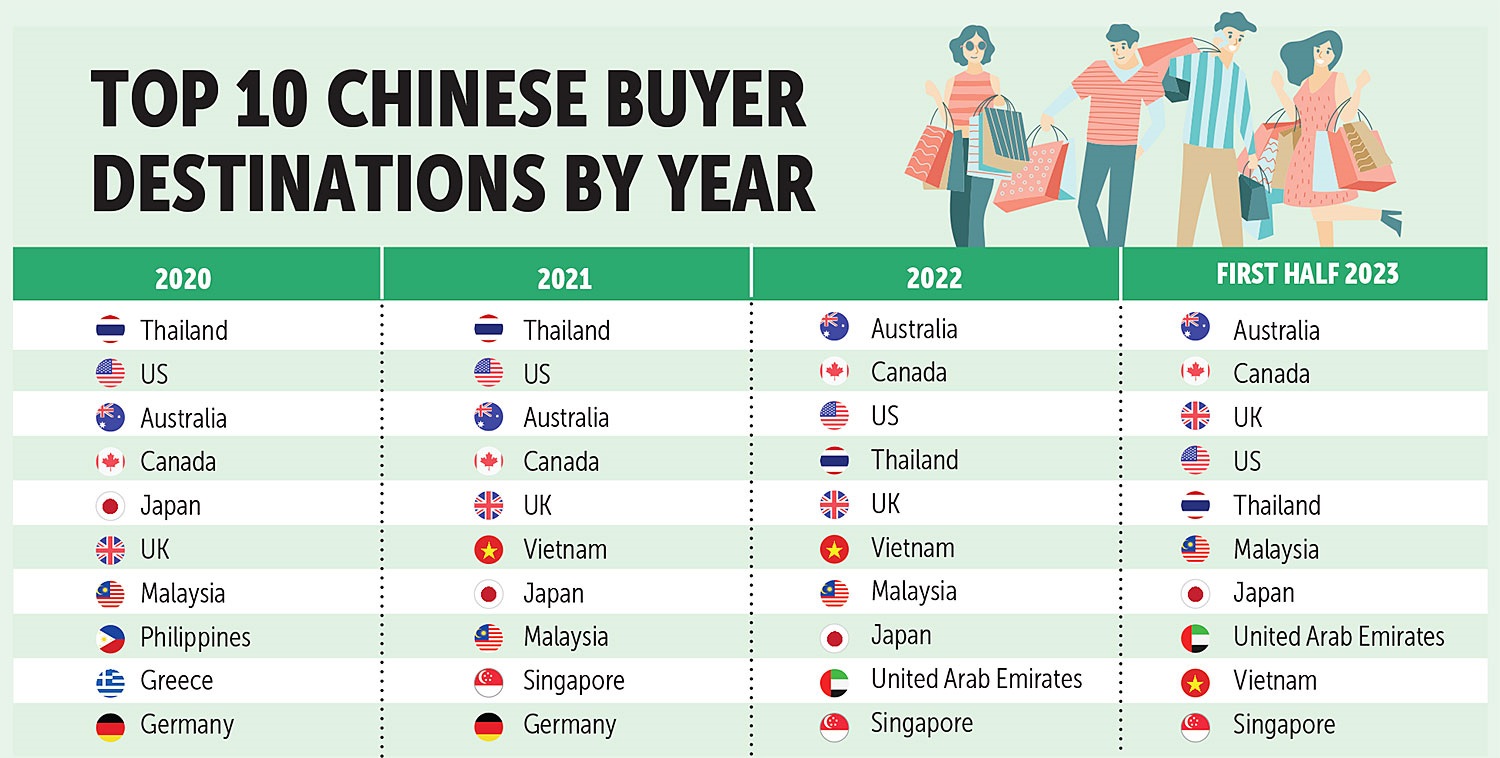Business
Thailand’s Property Market Cools as Chinese Head to Australia and Canada

Thailand has dropped to fifth place below Australia and Canada among Chinese property purchasers, down from last year and the top spot in 2021, owing to a slow travel recovery, expensive flights and market speculation.
According to Kashif Ansari, co-founder and group chief executive of Juwai IQI Group, a real estate marketing agency targeting the Chinese market, Chinese purchasers with lower budgets, who were historically Thailand’s main market, now make up a smaller share of all passengers.
“The pandemic had a devastating impact on outbound travel,” he explained.
“The rapid annual growth that propelled China to the top of the world’s tourist destinations came to an end in early 2020.” However, 2023 will be a watershed moment in the country’s recovery.”
Thongchai Busrapan, co-CEO of SET-listed Noble Development, said Chinese clients are still purchasing condo units at a lower rate than before the pandemic, but the trend is improving.
“The slowdown among Chinese buyers is due to a limited number of flights to Thailand and higher airfares,” he explained. “Several of our Chinese customers informed us that passport renewal was also difficult.”

Thailand;s Noble’s condo sales to Chinese buyers fell to 30% of overall sales to international buyers in the first half of 2023, down from more than half in 2019 and previous years.
According to Mr Thongchai, Taiwanese buyers have surpassed Chinese purchasers in the #1 spot because they choose the Thong Lor, Nana, and Rama IX regions. According to Juwai IQI, prior to the epidemic, Chinese visitors were the world’s largest outbound market.
Mainland travellers conducted 155 million outbound journeys and spent more than other nationalities on average, totaling US$255 billion, accounting for 17% of worldwide outbound travel expenditure.
According to UN figures, Chinese accounted for 30% of incoming visitors to Japan and 28% to Thailand.
Chinese tourists accounted for 16% of non-EU visitors in Germany. “Thailand expects at least 5 million Chinese visitors this year, down from about 13 million before Covid-19,” Mr Ansari stated.
He said that, depending on the destination, Chinese foreign property transactions dropped by more than 50% during the pandemic.
According to Mr Ansari, this revealed that about half of the transactions were dependent on the ability to travel. “As a result, we’re keeping an eye on the resumption of international travel,” he explained. “Wherever Chinese consumers step off the plane, increased property investment will follow.”
According to Juwai IQI, the top five nations for Chinese property purchases this year are Australia, Canada, the United Kingdom, the United States, and Thailand.
The top four are all prosperous Anglophone countries with world-class educational systems. Outbound Chinese travel has recovered, but not as quickly as many thought.
There is still a flight deficit, which keeps rates high. Capacity is barely 37% of what it was before the outbreak. Mr Ansari believes that China’s slow economic growth and volatile property markets are encouraging purchasers to go elsewhere.
The number of upper-middle and high-income households in the country is increasing, with an additional 71 million expected by 2025, bringing the total to 209 million. According to him, this implies a promising long-term demand for Thai tourism and property.

Chinese Property Buyers Investing Out of China
The Chinese have a lot of money to invest as well. According to official figures, the value of Chinese savings accounts increased by 26.3 trillion yuan (124 trillion baht) in the first nine months of 2022.
Immigration is on the rise, with 712,000 Chinese expats projected in Australia, Canada, and the United States by 2025. By 2025, the United States expects 3.7 million new migrants, including 513,000 from China.
Chinese citizens also participate in the majority of long-term visa programmes, often known as golden visas, accounting for 35% of the 20,844 Thai Elite members as of October 1, 2022.
Since borders reopened, traffic from China has recovered quickly, though not as quickly as many had hoped. The most significant impediment to a faster recovery is airline seat capacity and ticket costs.
For example, during the Dragon Boat Festival vacation, foreign airfare was double what it was in 2019. According to the National Immigration Administration, cross-border travel has rebounded to 65% of what it was in 2019.
Ctrip, a Chinese travel service provider, said that travel costs have gradually fallen. One-way air tickets, for example, cost 6% cheaper in June than in May. Hong Kong, Macau, Bangkok, Tokyo, and Singapore were the most popular destinations.
According to the latest Juwai IQI rating, Australia and Canada are the top overseas destination for Chinese property buyers in the first half of this year. Chinese desire for real estate Based on the amount of buyer inquiries received on the platform, Down Under surpassed their interest in other prominent markets such as Canada, the United Kingdom, and the United States, according to the research.
Although this commercial has not yet loaded, your article continues below.
The United Arab Emirates jumped from 13th to eighth place in 2021. Germany dropped out of the top ten, which also featured four Southeast Asian nations.
Over the next few years, a prolonged outflow will most certainly force Chinese property investments outside. According to the survey, around 712,000 people from the country will travel to the United States, Canada, and Australia between 2023 and 2025.
Capital flight from the mainland might surpass US$150 billion this year, as more people flee to safer havens in the face of new domestic regulations.

Business
PepsiCo Reduces Revenue Projections As North American Snacks And Key International Markets Underperform.

(VOR News) – In the third quarter of this year, Pepsi’s net income was $2.93 billion, which is equivalent to $2.13 per share. This was attributed to the company.
This is in stark contrast to net income of $3.09 billion, which is equivalent to $2.24 per share, during the same period in the previous year. The company’s earnings per share were $2.31 when expenses were excluded.
Net sales decreased by 0.6%, totaling $23.32 billion. Organic sales increased by 1.3% during the quarter when the effects of acquisitions, divestitures, and currency changes are excluded.
Pepsi’s beverage sales fell this quarter.
The most recent report indicates that the beverage and food sectors of the organization experienced a 2% decline in volume. Consumers of all income levels are demonstrating a change in their purchasing habits, as indicated by CEOs’ statements from the previous quarter.
Pepsi’s entire volume was adversely affected by the lackluster demand they encountered in North America. An increasing number of Americans are becoming more frugal, reducing the number of snacks they ingest, and reducing the number of times they purchase at convenience stores.
Furthermore, Laguarta observed that the increase in sales was partially attributed to the election that occurred in Mexico during the month of June.
The most significant decrease in volume was experienced by Quaker Foods North America, which was 13%. In December, the company announced its initial recall in response to a potential salmonella infection.
Due to the probability of an illness, the recall was extended in January. Pepsi officially closed a plant that was implicated in the recalls in June, despite the fact that manufacturing had already been halted.
Jamie Caulfield, the Chief Financial Officer of Pepsi and Laguarta, has indicated that the recalls are beginning to have a lessening effect.
Frito-Lay experienced a 1.5% decline in volume in North America. The company has been striving to improve the value it offers to consumers and the accessibility of its snack line, which includes SunChips, Cheetos, and Stacy’s pita chips, in the retail establishments where it is sold.
Despite the fact that the category as a whole has slowed down in comparison to the results of previous years, the level of activity within the division is progressively increasing.
Pepsi executives issued a statement in which they stated that “Salty and savory snacks have underperformed year-to-date after outperforming packaged food categories in previous years.”
Pepsi will spend more on Doritos and Tostitos in the fall and winter before football season.
The company is currently promoting incentive packets for Tostitos and Ruffles, which contain twenty percent more chips than the standard package.
Pepsi is expanding its product line in order to more effectively target individuals who are health-conscious. The business announced its intention to acquire Siete Foods for a total of $1.2 billion approximately one week ago. The restaurant serves Mexican-American cuisine, which is typically modified to meet the dietary needs of a diverse clientele.
The beverage segment of Pepsi in North America experienced a three percent decrease in volume. Despite the fact that the demand for energy drinks, such as Pepsi’s Rockstar, has decreased as a result of consumers visiting convenience stores, the sales of well-known brands such as Gatorade and Pepsi have seen an increase throughout the quarter.
Laguarta expressed his opinion to the analysts during the company’s conference call, asserting, “I am of the opinion that it is a component of the economic cycle that we are currently experiencing, and that it will reverse itself in the future, once consumers feel better.”
Additionally, it has been noted that the food and beverage markets of South Asia, the Middle East, Latin America, and Africa have experienced a decline in sales volume. The company cut its forecast for organic revenue for the entire year on Tuesday due to the business’s second consecutive quarter of lower-than-anticipated sales.
The company’s performance during the quarter was adversely affected by the Quaker Foods North America recalls, the decrease in demand in the United States, and the interruptions that occurred in specific international markets, as per the statements made by Chief Executive Officer Ramon Laguarta.
Pepsi has revised its forecast for organic sales in 2024, shifting from a 4% growth rate to a low single-digit growth rate. The company reiterated its expectation that the core constant currency profitability per share will increase by a minimum of 8% in comparison to the previous year.
The company’s shares declined by less than one percent during premarket trading. The following discrepancies between the company’s report and the projections of Wall Street were identified by LSEG in a survey of analysts:
SOURCE: CNBC
SEE ALSO:
Old National Bank And Infosys Broaden Their Strategic Partnership.
Business
Old National Bank And Infosys Broaden Their Strategic Partnership.

(VOR News) – Old National Bank, a commercial bank with its headquarters in the Midwest, and Infosys, a firm that specializes in information technology, have recently entered into a strategic expansion of their link, which has been in place for the past four years.
This expansion is more likely to take place sooner rather than later, with the likelihood being higher.
For the purpose of making it possible for Old National Bank to make use of the services, solutions, and platforms that are offered by Infosys, the objective of this expansion is to make it possible for the bank to transform its operations and processes through the application of automation and GenAI, as well as to change significant business areas.
This lets the bank leverage Infosys’ services, solutions, and platforms.
Old National Bank Chairman and CEO Jim Ryan said, “At Old National, we are committed to creating exceptional experiences for both our customers and our fellow employees.”
This statement is applicable to Old National Bank. Infosys is carefully managing the business process innovations that it is putting us through, putting a strong emphasis on efficiency and value growth throughout the process to ensure that it is carried out efficiently.
This is a routine occurrence throughout the entire operation. Because of Infosys’ dedication to our development and success, we are incredibly appreciative of the assistance they have provided.
Old National has been receiving assistance from Infosys in the process of updating its digital environment since the year 2020, according to the aforementioned company.
Ever since that time, the company has been providing assistance. The provision of this assistance has been accomplished through the utilization of a model that is not only powerful but also capable of functioning on its own power.
Infosys currently ranks Old National thirty-first out of the top thirty US banks.
This ranking is based on the fact that Old National is the nation’s largest banking corporation.
It is estimated that the total value of the company’s assets is approximately fifty-three billion dollars, while the assets that are currently being managed by the organization are valued at thirty billion dollars.
Dennis Gada, the Executive Vice President and Global Head of Banking and Financial Services, stated that “Old National Bank and Infosys possess a robust cultural and strategic alignment in the development, management, and enhancement of enterprise-scale solutions to transform the bank’s operations and facilitate growth.”
This remark referenced the exceptional cultural and strategic synergy between the two organizations. Dennis Gada is the one who asserted this claim. This was articulated explicitly concerning the exceptional cultural congruence and strategy alignment of the two organizations.
We are pleased to announce that the implementation of Infosys Topaz will substantially expedite the transformation of Old National Bank’s business processes and customer service protocols. We are exceedingly enthusiastic about this matter. We are quite thrilled about this specific component of the scenario.
Medium-sized banks operating regionally will continue to benefit from our substantial expertise in the sector, technology, and operations. This specific market segment of Infosys will persist in benefiting from our extensive experience. This phenomenon will enable this market sector to sustain substantial growth and efficiency benefits.
SOURCE: THBL
SEE ALSO:
American Water, The Largest Water Utility In US, Is Targeted By A Cyberattack
States Sue TikTok, Claiming Its Platform Is Addictive And Harms The Mental Health Of Children
Qantas Airways Apologizes After R-Rated Film Reportedly Airs On Every Screen During Flight
Business
American Water, The Largest Water Utility In US, Is Targeted By A Cyberattack

The largest regulated water and wastewater utility company in the United States stated Monday that it had been the target of a cyberattack, forcing the company to halt invoicing to consumers.
American Water, The Largest Water Utility In US, Is Targeted By A Cyberattack
American Water, based in New Jersey and serving over 14 million people in 14 states and 18 military facilities, said it learned of the unauthorized activity on Thursday and quickly took precautions, including shutting down certain systems. The business does not believe the attack had an impact on its facilities or operations and said employees were working “around the clock” to determine the origin and scale of the attack.

According to their website, American Water operates over 500 water and wastewater systems in around 1,700 communities across California, Georgia, Hawaii, Illinois, Indiana, Iowa, Kentucky, Maryland, Missouri, New Jersey, Pennsylvania, Tennessee, Virginia, and West Virginia.
SOURCE | AP
-

 News4 years ago
News4 years agoLet’s Know About Ultra High Net Worth Individual
-
Entertainment2 years ago
Mabelle Prior: The Voice of Hope, Resilience, and Diversity Inspiring Generations
-
News11 years ago
Enviromental Groups Tell Mekong Leaders Lao Dam Evaluation Process Flawed
-

 Health4 years ago
Health4 years agoHow Much Ivermectin Should You Take?
-

 Tech3 years ago
Tech3 years agoTop Forex Brokers of 2023: Reviews and Analysis for Successful Trading
-

 Lifestyles3 years ago
Lifestyles3 years agoAries Soulmate Signs
-

 Entertainment3 years ago
Entertainment3 years agoWhat Should I Do If Disney Plus Keeps Logging Me Out of TV?
-

 Health3 years ago
Health3 years agoCan I Buy Ivermectin Without A Prescription in the USA?